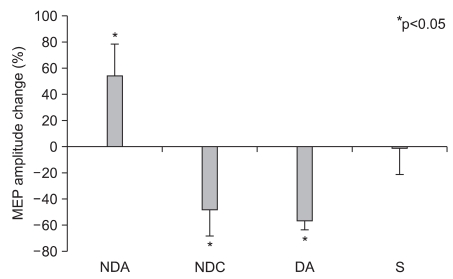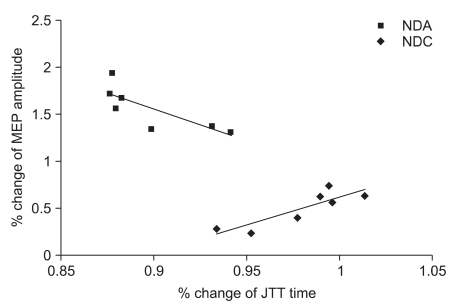Ann Rehabil Med.
2012 Feb;36(1):1-7. 10.5535/arm.2012.36.1.1.
Effect of Stimulation Polarity of Transcranial Direct Current Stimulation on Non-dominant Hand Function
- Affiliations
-
- 1Department of Rehabilitation Medicine, Chungnam National University School of Medicine, Daejeon 301-172, Korea. smfahen@cnuh.co.kr
- KMID: 2266774
- DOI: http://doi.org/10.5535/arm.2012.36.1.1
Abstract
OBJECTIVE
To evaluate motor excitability and hand function on the non-dominant side according to the polarity of transcranial direct current stimulation (tDCS) on the motor cortex in a healthy person. METHOD: tDCS was applied to the hand motor cortex for 15 minutes at an intensity of 1 mA in 28 healthy right-handed adults. Subjects were divided randomly into four groups: an anodal tDCS of the non-dominant hemisphere group, a cathodal tDCS of the non-dominant hemisphere group, an anodal tDCS of the dominant hemisphere group, and a sham group. We measured the motor evoked potential (MEP) in the abductor pollicis brevis and Jabsen-Taylor hand function test (JTT) in the non-dominant hand prior to and following tDCS. All study procedures were done under double-blind design.
RESULTS
There was a significant increase in the MEP amplitude and a significant improvement in the JTT in the non-dominant hand following anodal tDCS of the non-dominant hemisphere (p<0.05). But there was no change in JTT and a significant decrease in the MEP amplitude in the non-dominant hand following cathodal tDCS on the non-dominant hemisphere and anodal tDCS of the dominant hemisphere.
CONCLUSION
Non-dominant hand function is improved by increased excitability of the motor cortex. Although motor cortex excitability is decreased in a healthy person, non-dominant hand function is maintained. A homeostatic mechanism in the brain might therefore be involved in preserving this function. Further studies are warranted to examine brain functions to clarify this mechanism.
Keyword
Figure
Reference
-
1. Priori A, Berardelli A, Rona S, Accornero N, Manfredi M. Polarization of the human motor cortex through the scalp. Neuroreport. 1998; 9:2257–2260. PMID: 9694210.
Article2. Nitsche MA, Paulus W. Excitability changes induced in the human motor cortex by weak transcranial direct current stimulation. J Physiol. 2000; 527:633–639. PMID: 10990547.
Article3. Lang N, Nitsche MA, Paulus W, Rothwell JC, Lemon RN. Effects of transcranial direct current stimulation over the human motor cortex on corticospinal and transcallosal excitability. Exp Brain Res. 2004; 156:439–443. PMID: 14745467.
Article4. Nitsche MA, Liebetanz D, Antal A, Lang N, Tergau F, Paulus W. Modulation of cortical excitability by weak direct current stimulation-technical, safety and functional aspects. Suppl Clin Neurophysiol. 2003; 56:255–276. PMID: 14677403.5. Nitsche MA, Schauenburg A, Lang N, Liebetanz D, Exner C, Paulus W, Tergau F. Facilitation of implicit motor learning by weak transcranial direct current stimulation of the primary motor cortex in the human. J Cogn Neurosci. 2003; 15:619–626. PMID: 12803972.
Article6. Boggio PS, Castro LO, Savagim EA, Bratie R, Cruz VC, Rocha RR, Rigonatti SP, Silva MT, Fregni F. Enhancement of non-dominant hand motor function by anodal transcranial direct current stimulation. Neurosci Lett. 2006; 404:232–236. PMID: 16808997.
Article7. Hummel F, Celnik P, Giraux P, Floel A, Wu WH, Gerloff C, Cohen LG. Effects of non-invasive cortical stimulation on skilled motor function in chronic stroke. Brain. 2005; 128:490–499. PMID: 15634731.
Article8. Ko MH, Han SH, Park SH, Seo JH. Improvement of hand function with transcranial direct current brain polarization in stroke patients. J Korean Acad Rehabil Med. 2009; 33:259–264.9. Hesse S, Werner C, Schonhardt EM, Bardeleben A, Jenrich W, Kirker SG. Combined transcranial direct current stimulation and robot-assisted arm training in subacute stroke patients: a pilot study. Restor Neurol Neurosci. 2007; 25:9–15. PMID: 17473391.10. Kim DY, Park CI, Jung KJ, Ohn SH, Park KD, Park JB, Oh YT. Improvement of chronic post-stroke hemiparetic upper limb function after 2 weeks transcranial direct current stimulation. J Korean Acad Rehabil Med. 2009; 33:5–11.11. Gilio F, Rizzo V, Siebner HR, Rothwell JC. Effects on the right motor hand-area excitability produced by low-frequency rTMS over human contralateral homologous cortex. J Physiol. 2003; 551:563–573. PMID: 12821724.
Article12. Williams JA, Pascual-Leone A, Fregni F. Interhemispheric modulation induced by cortical stimulation and motor training. Phys Ther. 2010; 90:398–410. PMID: 20110339.
Article13. Chen R. Interactions between inhibitory and excitatory circuits in the human motor cortex. Exp Brain Res. 2004; 154:1–10. PMID: 14579004.
Article14. Vines BW, Nair D, Schlaug G. Contralateral and ipsilateral motor effects after transcranial direct current stuimulation. NeuroReport. 2006; 17:671–674. PMID: 16603933.15. Fregni F, Boggio PS, Mansur CG, Wagner T, Ferreira MJ, Lima MC, Rinonatti SP, Marcolin MA, Freedman SD, Nitsche MA, et al. Transcranial direct current stimulation of the unaffected hemisphere in stroke patients. NeuroReport. 2005; 16:1551–1555. PMID: 16148743.
Article16. Boggio PS, Nunes A, Rigonatti SP, Nitsche MA, Pascual-Leone A, Fregni F. Repeated sessions of noninvasive brain DC stimulation is associated with motor function improvement in stroke patients. Restor Neurol Neurosci. 2007; 25:123–129. PMID: 17726271.17. Nowak DA, Grefkes C, Ameli M, Fink GR. Interhemispheric competition after stroke: brain stimulation to enhance recovery of function of the affected hand. Neurorehabil Neural Repair. 2009; 23:641–656. PMID: 19531606.
Article18. Hackel ME, Wolfe GA, Bang SM, Canfield JS. Changes in hand function in the aging adult as determined by the Jebsen Test of Hand Function. Phys Ther. 1992; 72:373–377. PMID: 1631206.
Article19. Kim YH, Choi MS, Kim BO. Assessment of hand function in normal Korean Adults by Jebsen hand function test. J Korean Acad Rehabil Med. 1984; 8:5.20. Hummel FC, Heise K, Celink P, Floel A, Gerloff C, Cohen LG. Fascilitation skilled right hand motor function in older subjects by anodal polarization over the left primary motor cortex. Neurobiol Aging. 2010; 31:2160–2168. PMID: 19201066.
- Full Text Links
- Actions
-
Cited
- CITED
-
- Close
- Share
- Similar articles
-
- Non-Invasive Brain Stimulation for Treatment of Focal Hand Dystonia: Update and Future Direction
- Therapeutic Application of Transcranial Magnetic Stimulation and Transcranial Direct Current Stimulation in Depression
- Application of Non-invasive Brain Stimulation on Dysphagia after Stroke
- Transcranial Electrical Stimulation: Clinical Implication and Practice for Treatment of Psychiatric Illness
- Application of Non-invasive Brain Stimulation for Neurorehabilitation: Cerebellar Stimulation




